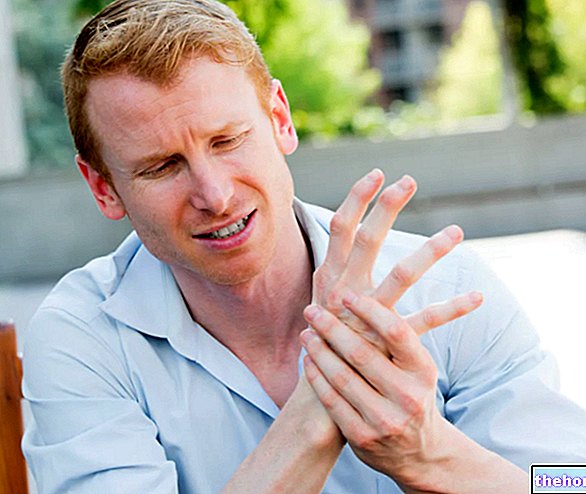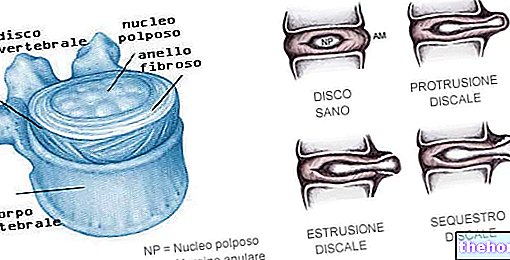Generality
A broken nose is an injury characterized by the fracture of one or both of the nasal bones. Generally, this fracture has a traumatic origin, so much so that the problem tends to affect more commonly people involved in car accidents, who play contact sports (such as rugby, football, boxing, etc.) or who are involved in physical struggles.

To diagnose a broken nose, a physical examination is sufficient.
Therapy depends on the severity of the injury: if the latter is particularly serious, surgery may also be required.
Definition
A broken nose is an injury that occurs when, after a facial trauma, the nasal bone structure breaks.
BONE ANATOMY OF THE NOSE

Figure: detail of the facial bones and skull; note how the ethmoid is considered a skull bone. From wikipedia.org
Classic situations in which you can break your nose.
- During contact sports, such as rugby
- Physical scuffles
- Car accidents
- Accidental falls to the ground
- Unintentional collisions, against doors or other objects
The bones of the nose, or nasal bones, are two, have a rectangular shape and are positioned next to each other, just under the frontal bone of the skull. Their size varies from person to person and these, together with the osteo-cartilage portion that makes up the nasal septum, determine the shape of an individual's nose.
The bones of the nose border on:
- The maxillary bones, in the latero-inferior position
- The lacrimal bones, in the latero-superior position
- The ethmoid, in a postero-superior position
- The vomer, in a postero-inferior position
Causes
The nose can break due to a blow to the face (facial trauma) of such intensity as to fracture one or both of the nasal bones.
The classic situations in which this can happen are: car accidents, fights that result in violent physical contact, contact sports (such as rugby, football, hockey, etc.) and accidental falls.
RISK FACTORS
The greatest risks are run by:
- Those who practice contact sports, especially if they train daily and if they do not wear the protections provided.
- Quarrelsome people, who "like" to be the protagonists of very heated arguments and arguments.
- Those who, driving a vehicle, have the bad habit of not fastening the seat belt.
- Cyclists, sportsmen and more.
- Those who practice weight lifting without proper equipment.
Symptoms and Complications
The condition of a broken nose involves: local aching and pain, which are sharpened to the touch; swelling of the nose and surrounding areas; nosebleed; hematomas around the nose and under the eyes; crooked or misshapen nose; respiratory difficulties; incessant discharge of mucus from the nostrils; finally, sensation of one or both nostrils closed.
WHEN DOES A BROKEN NOSE BECOME AN "EMERGENCY?
After a facial trauma involving the nose, it is advisable to seek medical attention for a consultation or for immediate intervention if:
- There was also a trauma to the head, which triggered headaches, neck pain, vomiting and unconsciousness.
- The individual is not breathing.
- The bleeding (or bleeding) from the nose shows no sign of stopping.
- The nose is not only swollen, but it definitely changes shape.
- A clear, watery fluid flows from the nasal nostrils.
COMPLICATIONS
If the impact that the trauma generates is particularly strong, or if the right and timely therapeutic remedies are not made, a broken nose can lead to various complications.
First, the nasal septum could undergo a deviation (deviated nasal septum) with narrowing or even blockage of one of the two nostrils.
Second, there is the possibility that the blood leaking after the trauma will clot at the nasal septum and form the so-called septal hematoma. The formation of a septal hematoma can dangerously block one or both nostrils and, if not drained, it can damage nearby cartilage structures.
The third possible complication is the rupture of the nasal cartilage (a set of structures that are important for supporting the nose and which help to delineate its shapes). The latter usually occurs when the trauma is very severe; it requires immediate surgery.
Finally, the fourth and final noteworthy complication relates to the possibility of a neck injury. The very strong impacts on the nose can, in fact, affect the cervical bones; in these cases, the doctor must intervene immediately.
Diagnosis
In most cases, a careful physical examination is sufficient to establish that the nose is broken.
Instrumental examinations, such as X-rays and CT scans (computerized axial tomography), are only considered if the facial trauma was very severe and also affected the neck and head.
OBJECTIVE EXAMINATION
During the physical examination, the doctor examines the nose by carefully palpating the swollen areas and visually exploring the internal cavities of the nasal nostrils.
Usually, so that the patient does not suffer pain during these checks, the doctor uses local anesthetics that he administers by spray or by injection.
Treatment
Therapeutic treatment for a broken nose depends on the severity of the fracture.
For a minor injury, it is sufficient to wait for natural healing; for a moderate or severe injury, on the other hand, manual or even surgical realignment is required.
Ice, pain relievers, and a few other simple remedies relieve bothersome symptoms, such as pain, swelling, and bleeding.
IN CASE OF MINOR INJURIES
Individuals with a mild nose fracture do not need specific treatments, they just have to wait for the natural healing of the broken nasal bones.
To relieve pain and swelling, it is essential to apply ice to the affected area, take pain relievers (such as acetaminophen) and take care to keep the head elevated at night.

Figure: external splint for the nose. The splines can sometimes also be internal.
Typically, the swelling passes within a week, while the hematoma subsides after about 14 days.
MANUAL ALIGNMENT
Moderate cases of broken noses can be treated with manual realignment surgery; during the operation the doctor adjusts the position of the nasal bones also thanks to special instruments.
The manual realignment procedure requires local anesthesia (practiced with an injection or with a nasal spray) and must be performed within 14 days of the fracture, ie before the fractured bones calcify.
Once calcification has taken place, the only solution is surgery.
Post-intervention phase
After the operation, the surgeon practices a bandage to protect the nose and attaches a sort of splint to it to maintain its alignment. Bandages and splinting should be kept for about a week.
The patient may be prescribed antibiotics to prevent infections.
The expected rest period is at least two weeks.
SURGICAL INTERVENTION
Surgery is required in case of:
- Severe fracture
- Multiple fracture
- Moderate fracture not promptly fixed with manual realignment surgery.
- Bone fracture associated with severe deviation of the nasal septum. In this case, a septoplasty is also performed.

Figure: before (left) and after (right) surgery.
The surgical operation has the same purpose as the manual realignment operation (thus adjusting the position of the nasal bones), but unlike the latter it is more invasive (incisions are provided) and requires general anesthesia.
The post-operative phase foresees absolute rest for at least two weeks.
USEFUL REMEDIES FOR BETTER RECOVERY
Regardless of the severity of the fracture, the best remedies for relieving symptoms and recovering are:
- Keep your head forward to keep the blood from leaking into your throat.
- Immediately apply ice to the affected area. It is best to do 4-5 compresses a day, lasting at least 10-15 minutes each. This is the so-called cryotherapy ("cold therapy"), which is highly effective in reducing swelling and the sense of pain.
- Take pain relievers. Paracetamol and ibuprofen (which is an NSAID) are particularly suitable.
- Keep your head raised above the rest of your body when you go to sleep to prevent swelling from getting worse.
- Rest until healing and avoid any dangerous sport for at least 6 weeks.
Prevention
Always fasten seat belts (even for short journeys), wear the protections provided for in certain sports (even in training) and, finally, get a bike helmet are the three most important preventive measures to avoid injuries such as a broken nose.




























